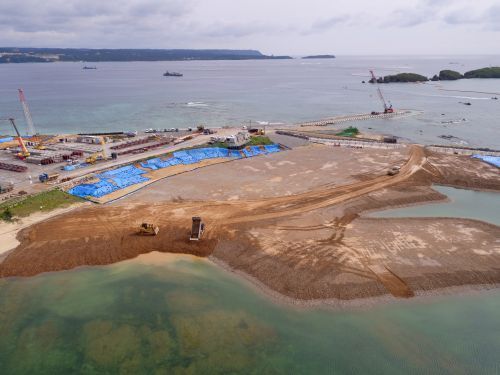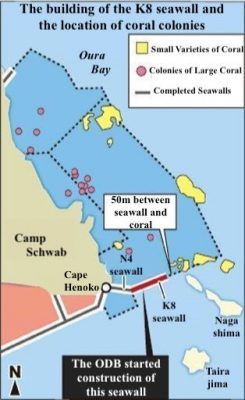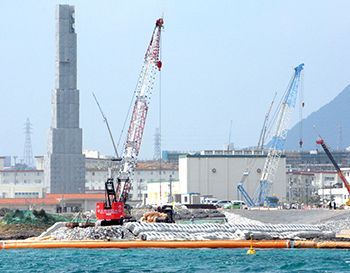ODB begins construction of K8 seawall in preparation for impending Oura Bay soil deposits

A photograph of the spot on the shore of Camp Schwab in Henoko where soil depositing is moving forward, taken on February 25, 2019. It has been pointed out that there may be an active fault in the vicinity of the long islet visible in the upper right-hand portion of the photograph. (Photograph taken via small drone)
March 5, 2019 Ryukyu Shimpo
By Manato Akira
On March 4 the Okinawa Defense Bureau (ODB), which is pushing forward construction of the Futenma Replacement Facility (FRF) in Henoko, began building the K8 seawall.
The ODB also aims to start depositing soil into the new land reclamation area on March 25, and to increase the number of spots for unloading soil.
Although coral colonies live on the ocean floor where the K8 seawall is to be built and in the surrounding area, the ODB has expressed its viewpoint that construction of a portion of the seawall can proceed without transplanting the coral.
Associate Professor Nami Okubo of Tokyo Keizai University, who specializes in the biology of coral, said that the construction will “change the tidal currents and raise the fatality rates of coral on the north side” of Cape Henoko.
This is the ninth seawall as part of construction of the whole facility upon which the ODB has begun construction work.
The N4 seawall, construction of which commenced at the end of January, has now reached its full length and work on the adjacent K8 seawall has begun.
On March 4 the ODB set up silt curtains in the vicinity of the planned K8 seawall construction In order to prevent water murkiness from spreading. Stones are not being placed yet.
The total length of the K8 seawall will be 515.1 meters. Construction of the wall is planned to proceed away from the shore, 250 meters in length, stopping about 50 meters short of a coral colony.
Initially, the plan was to transplant some varities of coral living at the K8 seawall construction site, but when the Okinawa Prefectural Government (OPG) did not authorize transplantation, the ODB decided it could construct a portion of the K8 seawall without transplanting coral.
An official of the ODB Procurement Planning Division stopped short when asked about the particulars of construction, such as the period of construction and whether or not seawalls will be used as spots for soil unloading.
This official simply stated, “From here on construction progress will also depend upon factors such as the weather and marine phenomena, so I will refrain from comment.”
On this day, citizens opposing the FRF protested against construction work in front of a gate to Camp Schwab and in front of the pier in Awa, Nago City, at which places soil for land reclamation was being hauled.
In front of the gate citizens protested commencement of new seawall construction, shouting, “Don’t ignore Okinawans’ will.” According to the protesters in front of the gate, 327 dump trucks hauled materials into Camp Schwab.
Protesters at Awa said that 473 trucks brought soil to the pier. No protesters took out in their protest boats or canoes due to tall waves in the ocean that day.
[Commentary] ODB efforts will not accelerate construction
The Japanese government has begun construction on a new seawall as part of FRF construction in Henoko, Nago City, and it has its sights set on commencing soil deposits into a new land reclamation area on March 25.
It is clear that the government plans to use the seawall now being built as an unloading spot for soil, and is aiming to accelerate construction to make the FRF a fait accompli.
Regardless of the construction now underway on the Henoko side of Cape Henoko progressing quickly, construction on the Oura Bay side is falling behind, and the timeframe necessary to complete construction is not getting any shorter.
According to the ODB’s application to the OPG for a land reclamation permit, the initial plan by the central government set a timeframe of the greater part of 5 years for construction on the Oura Bay side of Cape Henoko.
Because the government planned to run construction in the shallower waters of the Henoko side concurrently with that on the Oura Bay side, the Henoko side construction would not affect this construction period.
In a written statement submitted to the Ministry of Land, Infrastructure, Transport and Tourism (MLIT), the OPG pointed out, “As long as construction on the Oura Bay side seawalls has not commenced, the timeframe necessary for construction of the new Henoko base is the same as if construction never started.”
Actually, the government cannot start a majority of the construction work due to the discovery of soft ground on the Oura Bay side, and can only manifest a portion of the planned seawalls.

On March 4 around 1:30 p.m. workers set up silt curtains in preparation for soil deposits at the K8 seawall.
It is also important to note that prior to construction, dealing with the soft ground is expected to take five years minimum. If only Henoko side construction proceeds, the ODB’s progress will not result in the FRF being completed any sooner.
Some have indicated that due to these facts, construction of the FRF in Henoko will not lead to a quick closure and return of Futenma Air Station.
The foundation of the Japanese government’s argument, that either Futenma Air Station will be permanent or it will be relocated to Henoko, is shaken.
In the February prefectural referendum about 70 percent of voters said they oppose land reclamation work in Henoko. The Japanese government is disregarding the Okinawa referendum results and the land reclamation’s effects on the natural environment, yet it can be said that the government continuing construction work will not result in a shorter construction timeframe.
(English translation by T&CT and Erin Jones)
Previous Article:Mass protest held outside Prime Minister’s office: “Don’t bury Okinawa”
Next Article:Robert Kajiwara tells Governor Tamaki he hopes to convey Okinawa’s problems to the world
[Similar Articles]
- Postponement of seawall construction in Oura Bay for FY2020 on may be result of soft seabed
- ODB begins soil deposits into new land reclamation section in Henoko at 2:58 p.m. on March 25
- Deck barge enters Oura Bay in Henoko in effort to speed up land reclamation work
- MOD continues Henoko construction without transplanting rare coral, evading OPG engagement
- Adjustments to ODB’s plan for handling coral pushes soil depositing back to mid-August
 Webcam(Kokusai Street)
Webcam(Kokusai Street)


